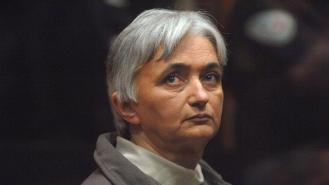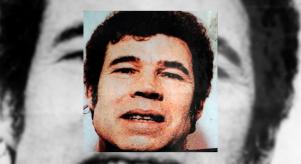
Who is France's most notorious killer?
Despite occasional incidents of civil unrest and some truly shocking acts of terrorism, modern-day France is a largely peaceful and civilised country. Renowned for its culture, its food, its art and its cinema; theirs is the language of love and their capital is the world’s most romantic city.
Look a little deeper, however, and we can see that ‘L'hexagone’ - like so many nations - is one built on violence. With such an incredibly bloodstained history, the France of today looks remarkably polite and agréable. And, largely, it is. That’s not to say, however, that the country doesn’t have its fair share of brutality.
Let’s demonstrate that by looking at France’s most savage serial killers.
Marcel Barbeault - 5 victims
We begin our dive into the cesspit of Gallic multiple murderers with a man known as ‘The Shadow Killer’ because of his propensity for attacking at night and hiding in the shadows. Marcel Barbeault is alleged to have shot and killed seven women and one man in Nogent-sur-Oise in the 1970s.
A veteran of The Algerian War, Barbeault strenuously denied being responsible for the deaths of Therese Adam, Suzanne Merienne, Annick Delisle, Mauricette Van Hyfte, Josette Routier, Julia Goncalves, Francoise Jakubowska and Eugene Stephan.
Three of the murder charges against him were later dropped due to a lack of evidence. However, the Liancourt-born killer was convicted of two counts of murder, three counts of unlawful killing, a litany of burglaries and a huge number of other lesser offences. He was sentenced to life in prison in June of 1981, where he remains to this day.
Patrice Alègre - 5 victims
Between 1989 and 1997, Patrice Alègre carried out at least five murders and six rapes in the southern city of Toulouse. That's what the police pinned on him in the end, but it’s believed that the numbers are higher than that.
Allegations of a police cover-up have dogged the Alègre case, with many of the victims' families bewildered as to how many of the deaths could be incorrectly recorded as suicides.
The assertions go much further and darker, with claims that top police and city officials not only covered up for the serial murderer but may have also ordered some of his kills to shield themselves from blackmail after attending Alègre's BDSM orgies. Some city officials stood down after the allegations went public. Alègre even attempted to implicate politician Dominique Baudis, the then-Toulouse mayor.
Alègre was eventually apprehended by French police in September 1997. He was given a life sentence which he is still currently serving.
Guy Georges - 7 victims
In the 1990s, Guy Georges stalked, snatched, attacked, tortured, raped and murdered seven women in the East Paris neighborhood of the Bastille. Because of this, he was dubbed 'The Beast of the Bastille' before he was identified by police.
At the time, the police's DNA database was siloed and decentralised, making sample comparison all but impossible. In what was a circumnavigation of French law - a judge ordered that the DNA samples be cross-referenced against the DNA records of the city’s private medical clinics. Doing so resulted in a match. Luckily, the controversial move didn't impact the court case against Guy Georges.
Georges was eventually arrested in March of 1998, seven years after he began his reign of terror, and instantly confessed. Described by psychiatrists as ‘a classic narcissistic psychopath', ‘The Beast’ was sentenced in 2001, receiving a life tariff.
Michel Fourniret - 8 victims
Michel Fourniret was responsible for murdering at least eight girls and young women (including British student Joanna Parrish) in the Ardennes region of northern France and in Belgium between 1987 and 2001.
As a 26-year-old, he served time for the sexual assault of a young child. While inside he began a pen pal relationship with a woman named Monique Olivier. In his letters, he confessed to dark fantasies involving the kidnap, rape and murder of young ‘virgin girls’. Olivier indulged these predilections and, when Fourniret was released in 1987, she became his accomplice. Monique Olivier assisted in many of her evil lover’s abductions, though never killed any of the young girls or women herself.
Fourniret was known as 'The Ogre of the Ardennes' until his arrest in June 2003. He was given two life sentences and died aged 79 in the secure unit of a Parisian hospital in 2021.

Joseph Vacher - 11 victims
For this murderer, we head back in time to the late 19th century, to a killer retrospectively referred to in his homeland as ‘The French Ripper’, due to his crimes’ parallels with a certain London-based slasher of the period.
A vagrant who operated in rural communities in the south east of the country, Vacher was a merciless and truly brutal serial killer who spent three years ruthlessly murdering teenage farm workers. He took the lives of at least 11 adolescents, but it’s speculated that his true victim count could be up to 30.
When caught, Vacher blamed having been bitten by a rabid dog as a child on his insatiable bloodlust. He later also claimed to have been sent by God to commit the murders. He was executed by guillotine in 1898 aged 29.
Thierry Paulin - 21 victims
In the mid-1980s, someone was stalking the streets of the 18th arrondissement of Paris, attacking elderly women. In total, ‘The Monster of Montmartre’ (also known as ‘The Grim Reaper of Paris’) claimed 21 victims. Parisian police eventually discovered that the culprit was Thierry Paulin.
Paulin was a sociopath and a hedonist. His love of unspeakably violent crime was matched only by his love of partying, drinking and taking drugs.
The most bloodthirsty of Paulin’s attacks occurred when he discovered that he was dying from AIDS. He committed his final wave of murders in a cold and heartless frenzy, trying to kill as many times as he could before he got too sick and died. Which he duly did in 1989, while awaiting trial.









